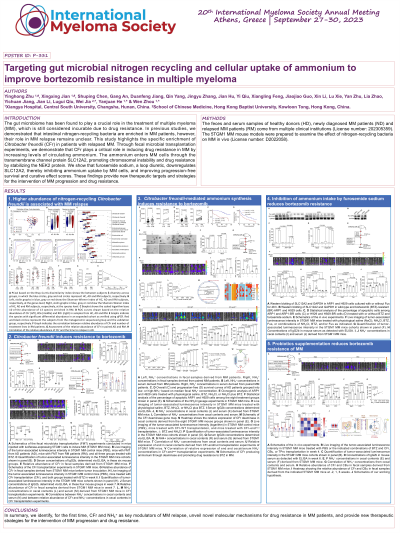Treatment of Relapsed/Refractory Myeloma
Poster Session 2
P-331: Targeting gut microbial nitrogen recycling and cellular uptake of ammonium to improve bortezomib resistance in multiple myeloma
Thursday, September 28, 2023
12:30 PM - 1:30 PM EEST


Wen Zhou, PhD
Xiangya Road110# Changsha, Hunan Province, China
Cancer Research Institute, Xiangya School of Medicine, Central South University, Hunan, China (People's Republic)
Introduction: Gut microbe alterations are closely related to the tumorigenesis and development of cancers. However, the relationship between gut microbe and drug resistance of multiple myeloma (MM) has not been reported.
Methods: The feces and serum samples of healthy donors (HD), newly diagnosed MM patients (ND) and relapsed MM patients (RM) come from multiple clinical institutions (License number: 202305359). The 5TGM1 MM mouse models were prepared to examine the effect of nitrogen-recycling bacteria on MM in vivo (License number: D2022058).
Results: To probe the difference in gut microbe between HD and MM patients, we performed shotgun metagenomic sequencing of fecal samples from a cohort of HD, ND and RM, and found that ND and RM show a significantly higher alpha diversity and Citrobacter freundii (CFr) was significantly enriched in RM. Owing to CFr is a nitrogen-recycling bacteria, we detected the concentration of NH4+ in MM patient's feces and serum, and found that NH4+ increased significantly in RM, and the relative abundance of CFr was positively correlated with NH4+ in feces and serum of RM. Subsequently, we confirmed that NH4+ can promote the drug resistance of MM cells to bortezomib (BTZ) through in vitro and in vivo experiments. Meanwhile, we constructed a CFr deaminase gene deletion (CFr-KO) strain, and found that CFr produces a large fraction of NH4+ by expressing deaminases, and NH4+ molecules produced in the intestinal tract subsequently enter the circulation and eventually travel to the bone marrow, causing MM cells to become resistant to BTZ. Finally, we treated MM cells with NH4+ and detected the expression of resistance related protein. It was found that NH4+ can upregulate the expression of NEK2, and NH4+ can increase the acetylation of NEK2 and reduce its ubiquitin degradation, thus maintaining its protein stability.
SLC12A2 as the key transmembrane transporter that mediates the uptake of NH4+ by MM cells, we discovered that furosemide sodium (Fus) can downregulate the expression of SLC12A2 in MM cells. Fus inhibits NH4+ uptake in MM cells and reduces the BTZ resistance-promoting effects of NH4+ supplementation in vitro and in vivo. Next, we analyzed the effect of Fus treatment in MM patients, finding that the MM patients treated with Fus achieved longer progression-free survival and higher curative effect scores. Finally, to explore additional strategies for tackling drug resistance in MM, we performed single Clostridium butyricum (CBu) and triple probiotic (TPro) transplantation by gavage, and we found that in keeping with the effect of CBu transplantation, TPro, an FDA-approved clinical drug, exhibited consistent efficacy in alleviating BTZ resistance.
Conclusions: In summary, we identify, for the first time, CFr and NH4+ as key modulators of MM relapse, unveil novel molecular mechanisms for drug resistance in MM patients, and provide new therapeutic strategies for the intervention of MM progression and drug resistance.
Methods: The feces and serum samples of healthy donors (HD), newly diagnosed MM patients (ND) and relapsed MM patients (RM) come from multiple clinical institutions (License number: 202305359). The 5TGM1 MM mouse models were prepared to examine the effect of nitrogen-recycling bacteria on MM in vivo (License number: D2022058).
Results: To probe the difference in gut microbe between HD and MM patients, we performed shotgun metagenomic sequencing of fecal samples from a cohort of HD, ND and RM, and found that ND and RM show a significantly higher alpha diversity and Citrobacter freundii (CFr) was significantly enriched in RM. Owing to CFr is a nitrogen-recycling bacteria, we detected the concentration of NH4+ in MM patient's feces and serum, and found that NH4+ increased significantly in RM, and the relative abundance of CFr was positively correlated with NH4+ in feces and serum of RM. Subsequently, we confirmed that NH4+ can promote the drug resistance of MM cells to bortezomib (BTZ) through in vitro and in vivo experiments. Meanwhile, we constructed a CFr deaminase gene deletion (CFr-KO) strain, and found that CFr produces a large fraction of NH4+ by expressing deaminases, and NH4+ molecules produced in the intestinal tract subsequently enter the circulation and eventually travel to the bone marrow, causing MM cells to become resistant to BTZ. Finally, we treated MM cells with NH4+ and detected the expression of resistance related protein. It was found that NH4+ can upregulate the expression of NEK2, and NH4+ can increase the acetylation of NEK2 and reduce its ubiquitin degradation, thus maintaining its protein stability.
SLC12A2 as the key transmembrane transporter that mediates the uptake of NH4+ by MM cells, we discovered that furosemide sodium (Fus) can downregulate the expression of SLC12A2 in MM cells. Fus inhibits NH4+ uptake in MM cells and reduces the BTZ resistance-promoting effects of NH4+ supplementation in vitro and in vivo. Next, we analyzed the effect of Fus treatment in MM patients, finding that the MM patients treated with Fus achieved longer progression-free survival and higher curative effect scores. Finally, to explore additional strategies for tackling drug resistance in MM, we performed single Clostridium butyricum (CBu) and triple probiotic (TPro) transplantation by gavage, and we found that in keeping with the effect of CBu transplantation, TPro, an FDA-approved clinical drug, exhibited consistent efficacy in alleviating BTZ resistance.
Conclusions: In summary, we identify, for the first time, CFr and NH4+ as key modulators of MM relapse, unveil novel molecular mechanisms for drug resistance in MM patients, and provide new therapeutic strategies for the intervention of MM progression and drug resistance.
